| Organic Seeds | Edible Plants | Organic Pest Controls | Books | Tools, Propagation & Fertilisers | Sprouting & Microgreens | Poultry Supplies | Specials & Gift Ideas |

Top

We will send an email to this address*
when is next available
* we will use this email address only for this notification and then we will delete it.
 Home
Home
Green Harvest Organic Gardening Supplies is permanently closed as of 5pm on 1-11-2023.
We will not be taking orders by this website, in person, by phone or email. Our display garden and retail shop are closed forever.
Read more...
Phone:07 54357000
Phone calls will only be responded to sporadically and only in reference to orders placed prior to 2-11-2023. All the useful growing and organic pest management research and resources are available on this website for a while still.
Feeding Your Chooks
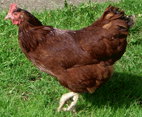 Chickens thrive on a varied diet that includes grain, forage greens and protein. Free-ranging chooks can get some of their
protein from insects, slugs, snails, worms and grubs. Poultry that are confined to a pen will need to get protein from
another source in addition to kitchen scraps. A good diet results in better health for the chickens and improves egg
quality.
Chickens thrive on a varied diet that includes grain, forage greens and protein. Free-ranging chooks can get some of their
protein from insects, slugs, snails, worms and grubs. Poultry that are confined to a pen will need to get protein from
another source in addition to kitchen scraps. A good diet results in better health for the chickens and improves egg
quality.A chicken will typically eat about 400g of commercial feed (mixed grain or pellets) per day (about a double handful per bird). If they have access to food scraps and lots of green pick, then about 200g is enough. Feeders and dispensers should be vermin-proof and keep the grain or mash dry; smooth PVC feeders make it harder for mice and rats to get at the feed. Vermin are a major problem as they also attract snakes.
Water
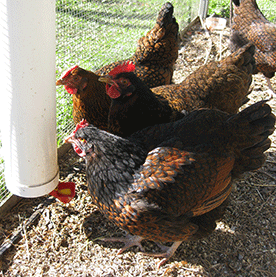 Cool, clean water needs to be available all the time. Hens drink about 250ml each per day but this can double in very hot
weather.
Cool, clean water needs to be available all the time. Hens drink about 250ml each per day but this can double in very hot
weather.
 Cool, clean water needs to be available all the time. Hens drink about 250ml each per day but this can double in very hot
weather.
Cool, clean water needs to be available all the time. Hens drink about 250ml each per day but this can double in very hot
weather.
Daily Routine
Hens usually lay about 4 hours after being fed, so it works well to feed them early in the morning, wait for laying to finish and then let them out to free range. Collect the eggs straight away as leaving them in the nest can encourage egg-eating and may attract reptiles. Feeding them early also keeps the neighbours happy as well-fed chooks are quieter. A regular schedule is important, once the chooks are used to it they will be easier to manage. Using a particular call when feeding also helps to train them to follow you, so if you need to put them away early, you can. Lock them in securely for the night as the sun goes down.
Hens usually lay about 4 hours after being fed, so it works well to feed them early in the morning, wait for laying to finish and then let them out to free range. Collect the eggs straight away as leaving them in the nest can encourage egg-eating and may attract reptiles. Feeding them early also keeps the neighbours happy as well-fed chooks are quieter. A regular schedule is important, once the chooks are used to it they will be easier to manage. Using a particular call when feeding also helps to train them to follow you, so if you need to put them away early, you can. Lock them in securely for the night as the sun goes down.
Designing Poultry Forage Systems
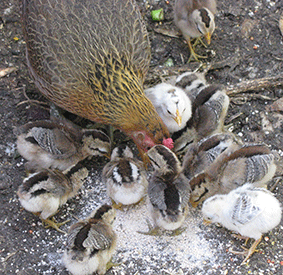 It is to your advantage to grow some food for the chooks as this will reduce feed bills and provide the chickens with a
healthy, varied diet. A wide range of nutrients enhances egg quality and lifts omega-3 levels, one of the reasons that
home-grown eggs taste so much better. Chooks need plenty of greens and as anyone who has watched chickens free-ranging will
attest, they love their veges! A well-designed forage system can also provide shade, vital in our hot summers and shelter
from hawks. There are various forage patch options, depending on the number of chooks and the space available:
It is to your advantage to grow some food for the chooks as this will reduce feed bills and provide the chickens with a
healthy, varied diet. A wide range of nutrients enhances egg quality and lifts omega-3 levels, one of the reasons that
home-grown eggs taste so much better. Chooks need plenty of greens and as anyone who has watched chickens free-ranging will
attest, they love their veges! A well-designed forage system can also provide shade, vital in our hot summers and shelter
from hawks. There are various forage patch options, depending on the number of chooks and the space available:
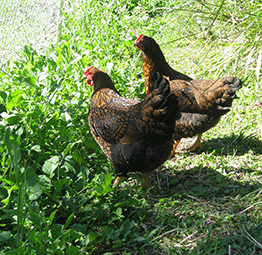 This is useful where there is no space available for free ranging. Grow forages where it is easy to harvest an armful of
greens every morning on the way to the chook run. Also plant forages where they are harvestable by the chooks, alongside
the run. The chooks can eat whatever pokes through the fence. Additionally you can set aside one or two garden beds for
long-lived poultry greens like
lucerne that can be cut multiple
times.
This is useful where there is no space available for free ranging. Grow forages where it is easy to harvest an armful of
greens every morning on the way to the chook run. Also plant forages where they are harvestable by the chooks, alongside
the run. The chooks can eat whatever pokes through the fence. Additionally you can set aside one or two garden beds for
long-lived poultry greens like
lucerne that can be cut multiple
times.
Multiple runs attached to the chook house
A chook area with multiple runs will allow you to cycle crops of forage greens for the chickens, in rotation. Even in a small backyard this can be achieved by using the external property fence as one boundary and then fencing a narrow runway 1.5 - 2 m wide on both sides of a chook house. By placing the chook house in the middle of the runways, with access to both, greens can be grown in one runway while the other one is being used. The runways are a good place to grow narrow fruit trees like bananas and pawpaw or dwarf stone fruit.
Any fruit trees planted in a chicken run will need protection from the chooks and their continuous scratching. Provide protection by placing wire cages around young trees. Scattering logs, concrete pavers or rocks across the top of the root zone of trees will prevent the roots being damaged by constant scratching. Fencing off areas of the chicken run will allow time for plants to establish.
A movable chook tractor
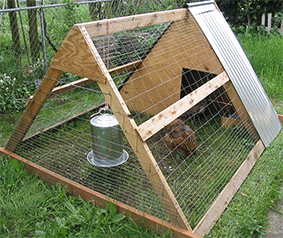 If you are using a chook tractor or portable coop it should be moved regularly onto fresh grass. It is a great help in
keeping pest problems to a minimum if you move the chook tractor onto a vege bed once the crop is finished. The chooks will
hunt down any pests, eat the last remnants of veges, scratch up the bed and manure it. Afterwards, with fresh mulch and a
few weeks rest, it will be ready to plant again.
If you are using a chook tractor or portable coop it should be moved regularly onto fresh grass. It is a great help in
keeping pest problems to a minimum if you move the chook tractor onto a vege bed once the crop is finished. The chooks will
hunt down any pests, eat the last remnants of veges, scratch up the bed and manure it. Afterwards, with fresh mulch and a
few weeks rest, it will be ready to plant again.
A poultry forage system combined with fruit trees
A larger poultry forage system can be combined with an orchard, simply by placing extra plants for chicken forage in amongst the fruit trees. The fruit trees will need to be well established before the chooks are allowed to free range, to prevent damage to young trees. Maintain the number of poultry at a level where a continuous groundcover is always present. If the ground is being completely bared, then you have too many chooks for the area.
If you turn your orchard into a poultry forage system you will reduce your need for fertiliser, mowing and pest control. The chickens will be happier provided with both shade and entertainment. Chooks are very industrious when it comes to catching insects, particularly fruit fly and codling moth.
 It is to your advantage to grow some food for the chooks as this will reduce feed bills and provide the chickens with a
healthy, varied diet. A wide range of nutrients enhances egg quality and lifts omega-3 levels, one of the reasons that
home-grown eggs taste so much better. Chooks need plenty of greens and as anyone who has watched chickens free-ranging will
attest, they love their veges! A well-designed forage system can also provide shade, vital in our hot summers and shelter
from hawks. There are various forage patch options, depending on the number of chooks and the space available:
It is to your advantage to grow some food for the chooks as this will reduce feed bills and provide the chickens with a
healthy, varied diet. A wide range of nutrients enhances egg quality and lifts omega-3 levels, one of the reasons that
home-grown eggs taste so much better. Chooks need plenty of greens and as anyone who has watched chickens free-ranging will
attest, they love their veges! A well-designed forage system can also provide shade, vital in our hot summers and shelter
from hawks. There are various forage patch options, depending on the number of chooks and the space available:
- Cutting greens
- Multiple runs attached to the chook house
- A movable chook tractor
- A poultry forage system combined with fruit trees
 This is useful where there is no space available for free ranging. Grow forages where it is easy to harvest an armful of
greens every morning on the way to the chook run. Also plant forages where they are harvestable by the chooks, alongside
the run. The chooks can eat whatever pokes through the fence. Additionally you can set aside one or two garden beds for
long-lived poultry greens like
lucerne that can be cut multiple
times.
This is useful where there is no space available for free ranging. Grow forages where it is easy to harvest an armful of
greens every morning on the way to the chook run. Also plant forages where they are harvestable by the chooks, alongside
the run. The chooks can eat whatever pokes through the fence. Additionally you can set aside one or two garden beds for
long-lived poultry greens like
lucerne that can be cut multiple
times.Multiple runs attached to the chook house
A chook area with multiple runs will allow you to cycle crops of forage greens for the chickens, in rotation. Even in a small backyard this can be achieved by using the external property fence as one boundary and then fencing a narrow runway 1.5 - 2 m wide on both sides of a chook house. By placing the chook house in the middle of the runways, with access to both, greens can be grown in one runway while the other one is being used. The runways are a good place to grow narrow fruit trees like bananas and pawpaw or dwarf stone fruit.
Any fruit trees planted in a chicken run will need protection from the chooks and their continuous scratching. Provide protection by placing wire cages around young trees. Scattering logs, concrete pavers or rocks across the top of the root zone of trees will prevent the roots being damaged by constant scratching. Fencing off areas of the chicken run will allow time for plants to establish.
A movable chook tractor
 If you are using a chook tractor or portable coop it should be moved regularly onto fresh grass. It is a great help in
keeping pest problems to a minimum if you move the chook tractor onto a vege bed once the crop is finished. The chooks will
hunt down any pests, eat the last remnants of veges, scratch up the bed and manure it. Afterwards, with fresh mulch and a
few weeks rest, it will be ready to plant again.
If you are using a chook tractor or portable coop it should be moved regularly onto fresh grass. It is a great help in
keeping pest problems to a minimum if you move the chook tractor onto a vege bed once the crop is finished. The chooks will
hunt down any pests, eat the last remnants of veges, scratch up the bed and manure it. Afterwards, with fresh mulch and a
few weeks rest, it will be ready to plant again.A poultry forage system combined with fruit trees
A larger poultry forage system can be combined with an orchard, simply by placing extra plants for chicken forage in amongst the fruit trees. The fruit trees will need to be well established before the chooks are allowed to free range, to prevent damage to young trees. Maintain the number of poultry at a level where a continuous groundcover is always present. If the ground is being completely bared, then you have too many chooks for the area.
If you turn your orchard into a poultry forage system you will reduce your need for fertiliser, mowing and pest control. The chickens will be happier provided with both shade and entertainment. Chooks are very industrious when it comes to catching insects, particularly fruit fly and codling moth.
Choosing Forage Plants
Leafy Vegetables
Chickens love greens and will eat a wide variety. Don't underestimate the sheer quantity they can get through. It is a good habit to always give them the outside leaves of any big, leafy vegetable you have harvested from the garden such as cauliflower, cabbage, bok choy, mustard or old broccoli plants. They will not only eat the leaves but clean up any caterpillars or snails lurking amongst the foliage. Greens also supply chlorophyll, one of the reasons free range eggs have such a lovely deep yellow colour.
Weeds as Greens
When weeding the garden it is worthwhile becoming familiar with the chook favourites and putting them into a bucket for the chooks to enjoy. Some of the names are a good indicator - like Fat Hen Chenopodium album and Chickweed Stellaria media. Other weeds like purslane syn. pigweed Portulaca oleracea, Cleavers Galium aperine, Dandelion Taraxacum officinale and Stinging nettles Urtica dioica will readily be eaten.
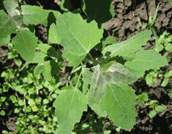
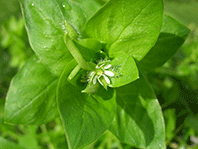
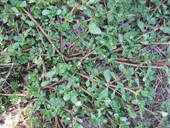
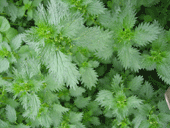
Clucker Tucker™ Seed Mix
This is a hardy collection of leafy greens Green Harvest has specifically designed so you can grow the plants your flock will enjoy. It includes favourite forage foods such as bok choy, buckwheat, barrel medic, forage chicory, clover, cocksfoot, linseed, lucerne, millet, forage plantain, silverbeet, subclover and sunflower. Most have vigorous root systems that will quickly regrow leaves that are cut or eaten. It is a blend of annual and perennial plants, many of which will self-sow. In a forage area, seed can be broadcast; the chooks will need to be kept off the area for the plants to establish. After they have grazed it down, the chooks should be taken off to allow the plants to reshoot. Where space is limited, grow the mix in seedling trays and once grown, place it in the chook run or bird cage. In temperate areas sow March - May or August - October. In subtropical areas sow August - September or May - July. In tropical areas sow April - August.
Perennial Plants
Perennial plants can be grown wherever you can tuck them in around the garden. When planted on the outside of the chook run, along the fence edges, they can be self-service greens but the fence will prevent the chooks demolishing the whole plant in one go. If you plant downslope of the chook run it will help to capture nutrients that wash out of the run during heavy rain.
Good choices for hardy perennial greens:
Mulberry (useful deciduous tree for chook runs as it will let winter sun in), lillypilly or other native bushfoods, persimmon, pawpaw, feijoa, cherry guava, tamarillo, custard apple, peach, banana (old stems can be chopped up too), fig, jaboticaba, grumichama, Brazilian cherry and pears.
Trees and Shrubs with Seeds or Pods
Some plants are useful for planting in larger areas as the seeds are a high protein food source: tree lucerne / tagasaste, wattle and pigeon pea.
Vines for Fences and Trellis
These vines planted on chook fences can provide shade as well as food: banana passionfruit, black passionfruit, choko, grapes, cucumber, beans and Ceylon spinach.
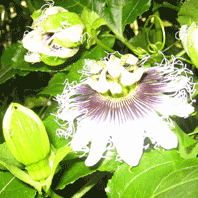
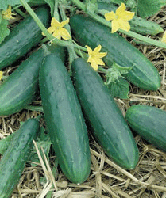
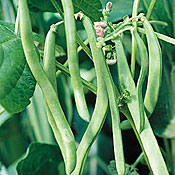
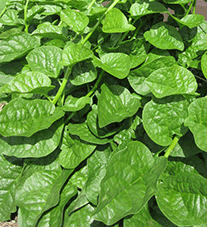
Seeds for Sowing in Rotation Runs
Clucker Tucker™ seed mix, sunflower, corn, millet, buckwheat, chicory, chickpea, plantain, sorghum, wheat, oats, barley, lucerne, soybean and clover.
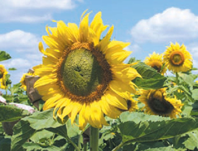
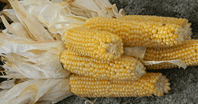
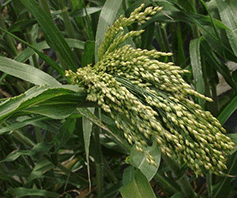
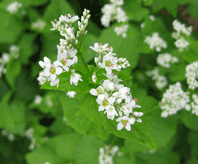
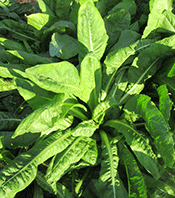
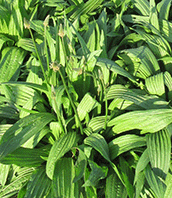

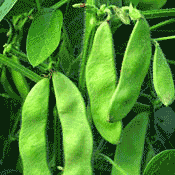
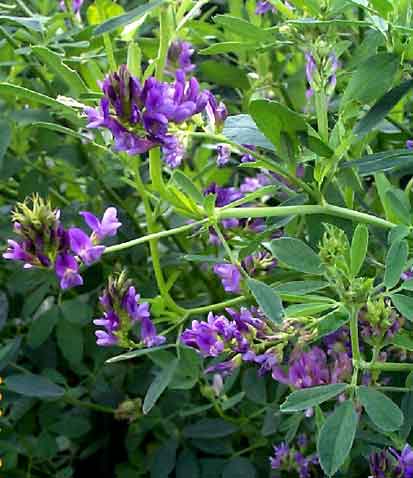
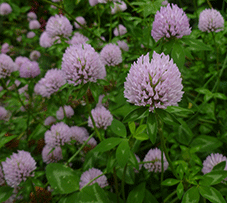
You can find books on poultry care here.
Leafy Vegetables
Chickens love greens and will eat a wide variety. Don't underestimate the sheer quantity they can get through. It is a good habit to always give them the outside leaves of any big, leafy vegetable you have harvested from the garden such as cauliflower, cabbage, bok choy, mustard or old broccoli plants. They will not only eat the leaves but clean up any caterpillars or snails lurking amongst the foliage. Greens also supply chlorophyll, one of the reasons free range eggs have such a lovely deep yellow colour.
Weeds as Greens
When weeding the garden it is worthwhile becoming familiar with the chook favourites and putting them into a bucket for the chooks to enjoy. Some of the names are a good indicator - like Fat Hen Chenopodium album and Chickweed Stellaria media. Other weeds like purslane syn. pigweed Portulaca oleracea, Cleavers Galium aperine, Dandelion Taraxacum officinale and Stinging nettles Urtica dioica will readily be eaten.




Clucker Tucker™ Seed Mix
This is a hardy collection of leafy greens Green Harvest has specifically designed so you can grow the plants your flock will enjoy. It includes favourite forage foods such as bok choy, buckwheat, barrel medic, forage chicory, clover, cocksfoot, linseed, lucerne, millet, forage plantain, silverbeet, subclover and sunflower. Most have vigorous root systems that will quickly regrow leaves that are cut or eaten. It is a blend of annual and perennial plants, many of which will self-sow. In a forage area, seed can be broadcast; the chooks will need to be kept off the area for the plants to establish. After they have grazed it down, the chooks should be taken off to allow the plants to reshoot. Where space is limited, grow the mix in seedling trays and once grown, place it in the chook run or bird cage. In temperate areas sow March - May or August - October. In subtropical areas sow August - September or May - July. In tropical areas sow April - August.
Perennial Plants
Perennial plants can be grown wherever you can tuck them in around the garden. When planted on the outside of the chook run, along the fence edges, they can be self-service greens but the fence will prevent the chooks demolishing the whole plant in one go. If you plant downslope of the chook run it will help to capture nutrients that wash out of the run during heavy rain.
Good choices for hardy perennial greens:
- Comfrey is easily the best herb to grow for chooks.
- Queensland Arrowroot: an essential plant in warmer climates, as it provides a cool refuge on hot days. The high moisture-holding stems create an air-conditioned effect inside a big clump. The leaves are an attractive forage and you will need a big patch to prevent it being demolished by hungry hens.
- New Zealand spinach syn. Warrigal greens is a highly nutritious tonic food, rich in protein and B12. A very useful year-round groundcover for temperate areas; it is only vigorous in winter and spring in the subtropics. The juicy leaves are appreciated by poultry and it self-sows readily.
- Sweet Potato vines are useful groundcovers in frost-free areas for under fruit trees and are relished by the chooks.
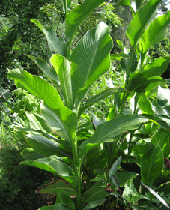
Mulberry (useful deciduous tree for chook runs as it will let winter sun in), lillypilly or other native bushfoods, persimmon, pawpaw, feijoa, cherry guava, tamarillo, custard apple, peach, banana (old stems can be chopped up too), fig, jaboticaba, grumichama, Brazilian cherry and pears.
Trees and Shrubs with Seeds or Pods
Some plants are useful for planting in larger areas as the seeds are a high protein food source: tree lucerne / tagasaste, wattle and pigeon pea.
Vines for Fences and Trellis
These vines planted on chook fences can provide shade as well as food: banana passionfruit, black passionfruit, choko, grapes, cucumber, beans and Ceylon spinach.




Seeds for Sowing in Rotation Runs
Clucker Tucker™ seed mix, sunflower, corn, millet, buckwheat, chicory, chickpea, plantain, sorghum, wheat, oats, barley, lucerne, soybean and clover.










You can find books on poultry care here.
 Home
Home
Green Harvest Organic Gardening Supplies is permanently closed as of 5pm on 1-11-2023.
We will not be taking orders by this website, in person, by phone or email. Our display garden and retail shop are closed forever.
Read more...
Phone:07 54357000
Phone calls will only be responded to sporadically and only in reference to orders placed prior to 2-11-2023. All the useful growing and organic pest management research and resources are available on this website for a while still.
No liability will be accepted by Green Harvest, its owners or employees as to the accuracy of any information. No responsibility will be taken for damage to property or persons due to information given about a product or technique. No responsibility will be taken for the loss of a crop or income due to information given about a product or technique.
 Shopping here is private and secure.
Shopping here is private and secure.
Copyright © 2001 - 2024 Green Harvest Organic Gardening Supplies
No part of this website may be reproduced without permission of the owner